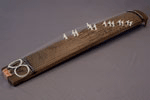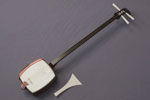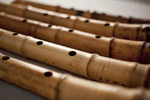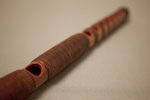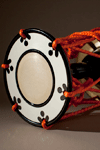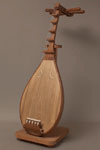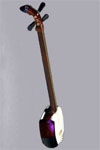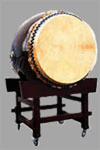
SHAMISEN
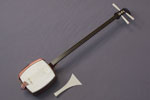
Also known as sangen, the Chinese sanxian, made its way via Okinawa to Japan. As per the name, has three strings and in China and Okinawa were covered in snake skin, while on mainland Japan, cat and dog skin is used. While only used in Japan since modern times, from kabuki theatre, puppet plays and other such theatre music, accompaniment to singing, and folk songs from many regions, the shamisen is widely loved.
There are a variety of standard shamisen which vary according to genre from hosozao (thin neck) to futazao (thick neck) and also a diverse range of bachi, plectrums, and koma, bridges. Also characteristic is the formation of a lingering resonance called sawari, from the string lightly touching the surface of the neck, when striking the strings, knocking the plectrum on the skin. A diverse range of tunings, based on the perfect fourth and perfect fifth combined hon-chōshi tuning, including the second string raised one tone, ni-agari and the third string lowered one tone, san-sagari.
Moreover, the reference tone can be configured to suite a singer or other instruments. But it is usual to choose between h (si) and d (re) and regardless of the real pitch when the Western five-lined staff notation is used, h is often used for the first string.
Music Library
- Banshiki cho
- Kinichi Nakanoshima
(1904-1984) - 1941
- play
- Banshiki in Gagaku Japanese traditional court music pitch notation, equivalent to the German pitch notation, H. Composed by Kinichi Nakanoshima, both a composer and Yamada school Koto musician. Also known as a shamisen virtuoso.
- Sarashi
- Kōtō Kitazawa,
Fukakusa Kengyō - Year UNK*
- play
- Original piece by Kitazawa Kōtō (late 1600s) later arranged by Fukakusa Kengyo (early 1700s). Depicting the bleaching of cloth in the Uji River, Kyoto. Famous for instrumental interludes, ainote, and nagauta “Echigoya Jishi.”
- Matsukaze
(Wind in Pine) - Nakanoshima Kengyō I (1838-1894),
Yamaki Kengyō III(1835/37-1871/73) - Year UNK*
- play
- Shamisen part composed by Nakanoshima Kengyō I. Koto part composed by Yamaki Kengyō III. Uses ainote, instrumental interludes, and distinctive sounds known as kinuta. Also, Kinichi Nakanoshima is the composer's grandchild.
- The Road
- Yoko Sato
- 2007
- play
- under construction
* Composer UNK:Name of composer unknown. Year UNK:Year of composition unknown.
Performance by Yōko Kimura, Tetsuya Nozawa
In each episode, when staff notation is applicable, it is standardized by absolute pitch notation.




















